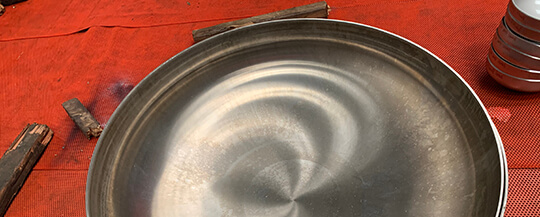1. Mechanical factors
Generally, heads with a diameter of more than 1200mm are relatively large and need to be spliced and then stamped and formed.
2. Analysis of cold working residual stress
After solution treatment, austenitic stainless steel has good toughness. If the solution treatment is improper or after other processes, some of the austenite will undergo structural changes, which will make the material contain martensite and have magnetism, and the strength of the material will increase, but the toughness will decrease. This affects the cold drawing performance of the material, even if the chemical composition and mechanical properties are within the standard range, it may not fully meet the needs of cold drawing forming of the head. After head pressing and cold drawing, part of the austenite is transformed into martensite or ferrite, the strength of the material is further enhanced, and the toughness becomes worse.
During the stamping and manufacturing process of the cumene base washing tank head, the deformation of the straight side section of the container head is increased due to the extrusion of the die, and deformed martensite will be produced during processing, which will lead to stress concentration, work hardening and iron production. Magnetic, and the cylinder has uniform deformation and small plastic deformation, which is lower than the deformation required for its magnetic transformation, so it is non-magnetic or weakly magnetic. Deformed martensite is one of the factors that cause greater stress in austenitic stainless steel heads.
Due to the uneven plastic deformation during the cold working process, cold working residual stress will be generated, the inner surface is stretched, and the outer surface is compressed. The stamping head is cold processed and formed, and the work hardening reduces the plasticity of the material. At this time, the residual stress will have a greater impact on the brittle fracture tendency, fatigue life and stress corrosion cracking of the head, especially for austenitic stainless steel. Reduce its resistance to intergranular corrosion. The excessive arcs and straight edge sections formed by the stamping of the head of the cumene alkali washing tank are the places where the plastic deformation is the greatest, and there is a large amount of tensile stress, so many cracks are found at the outer bends of the head.
3. Influence of welding stress
When the head is assembled, each assembly will cause welding residual stress during the welding process, film stress caused by internal pressure, and thermal stress caused by the frequent alternation of heating and cooling due to the requirements of chemical processes. Large tensile stress is generated in the area near the weld. The cracks detected by the coloring of the cumene alkaline washing tank started on the base material near the girth weld, not weld cracks. The microstructure at the crack is analyzed into austenite and martensite formed by phase transformation induced during deformation and welding. The head of the cumene alkaline washing tank is welded by splicing method, and the diameter of the head is too large, which is assembled and installed on site. After welding, the head was not subjected to stress relief annealing treatment, resulting in a large amount of martensite structure in the heat affected zone of the weld, and the hardness was high. The equipment has manufacturing defects in the manufacturing process. The local high temperature and uneven plastic deformation during welding cause residual stress in the welded joint after the weld is cooled to room temperature, and the corrosion resistance of the metal at the weld and heat-affected zone will decrease. When in contact with the medium, the corrosion of the medium will cause the groove-shaped micro seam at the bottom of the weld to cause stress corrosion cracking. The material properties of the heat-affected zone in the welded joint are the worst, and it has been found in the inspection that the base material of the head has coarse grain size and decreased strength. Therefore, the performance of the materials in the heat-affected zone must be more obvious. The cracks found in the coloring test are concentrated in the heat-affected zone of the head weld.
In view of the above-mentioned factors causing stress corrosion of the head, the following measures can be taken to eliminate stress corrosion.
1. Strictly control the composition of the stainless steel head material;
2. Multi-layer welding is used to prevent columnar crystal structure from being produced, reduce segregation, and improve the comprehensive mechanical properties of the weld;
3. When using the stamping method to manufacture austenitic stainless steel heads, control the stamping deformation to less than 15% to reduce the generation of martensite structure. After cold forming, it should be strictly related to "JBT4746-2002 Steel Pressure Vessel Heads" Heat treatment is required to reduce hardness and residual stress and eliminate deformed martensite;
4. Strictly implement the welding process to reduce welding residual stress. In addition, in the process, the NaOH concentration should be avoided to the greatest extent, the fluctuation of pH and temperature should be controlled, and the water should be replaced for many times when the treatment is suspended to avoid excessively high residual alkali concentration.
